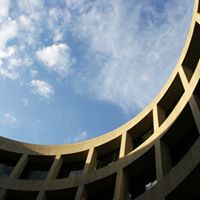Hirshhorn To Restage Krzysztof Wodiczko Projection on Museum Exterior
The Smithsonian’s Hirshhorn Museum and Sculpture Garden has announced the restaging of “Hirshhorn Museum, Washington, D.C.,” an iconic large-scale, outdoor projection by acclaimed American artist Krzysztof Wodiczko (b. 1943, Warsaw), on view Feb. 13–15, 6:30–9 p.m. for the first time since its original three-night display nearly 30 years ago. The work coincides with “Brand New: Art and Commodity in the 1980s,” a new exhibition exploring the collision of art and marketing in the 1980s opening Feb. 14. The comprehensive group show will also include Wodiczko’s renowned “Homeless Vehicle No. 5.” (1988–89), a device designed to provide homeless individuals––who were growing in numbers at the end of the decade—with some form of autonomy, containing shelter, a sink and storage.
After viewing the projection, visitors can explore “Brand New” during special late hours Feb. 13–15, from 6:30 to 9 p.m., and join Wodiczko and the Guerrilla Girls for a public artist talk on “Brand New” and the art of the ’80s, Feb. 13. Gallery Guides will also be on the National Mall and in the museum’s lobby to answer questions and host conversations about the work.
The celebrated three-story-tall installation, commissioned by the Hirshhorn and created specifically for its uniquely curved architecture, debuted in 1988 as part of the museum’s “WORKS” program, which ran from 1987 to 1993 and featured a series of temporary, site-specific exhibitions by artists such as Sol Lewitt, Ann Hamilton, Matt Mullican and Alfredo Jaar installed throughout the museum’s grounds and plaza. Wodiczko’s work, “Hirshhorn Museum, Washington, D.C.,” referenced widespread ’80s debates around the 1988 Presidential election’s political rhetoric, reproductive rights and the death penalty, by alluding to the power of mass media to convey ideologies at a time when cable TV was changing the media paradigm.
Wodiczko was at the forefront of a new interest in public art, and his work, including “Hirshhorn Museum, Washington, D.C.,” reflects an increased political awareness in the art of the period, spurred by forces such as the rise of homelessness, the AIDS epidemic and the polarization of U.S. politics. Using recognizable imagery––body parts, figures, guns and money––Wodiczko’s large-scale projections are open to interpretation by the communities who experience them, and in the political and social climate where they are installed. His large iconic images borrow from film and advertisements of the day, which used oversized pictures to elicit an emotional reaction in the viewer, and by projecting on monuments and other public institutions, he raised awareness around contemporary social issues.
“The 30-year-old projection appears to me today strangely familiar and at once unbearably relevant,” Wodiczko said. “I wrote in 1988 that, more than ever before, the meaning of our monuments depends on our active role in turning them into sites of memory and critical evaluation of history as well as places of public discourse and action. It remains vitally true.”
“We are honored to present Wodiczko’s ‘Hirshhorn Museum, Washington, D.C.’ nearly 30 years after it premiered to Washington audiences,” said Hirshhorn Director Melissa Chiu. “This projection is a significant public artwork from the 1980s. It exemplifies themes explored in ‘Brand New,’ and highlights the reaction of artists to the seismic shifts in economy, politics and technology that transformed the decade.”
Wodiczko joins the Hirshhorn’s 2017–18 schedule of diverse contemporary artists whose work reflects global conversations that shape history, politics and culture, including Chinese artist Ai Weiwei, German artist Georg Baselitz, Russian artists Ilya and Emilia Kabakov and American artists Mark Bradford, Arthur Jafa and Yoko Ono.
Tuesday, Feb. 13
Special evening hours, 6:30–9 p.m.
Krzysztof Wodiczko projection on view
“Brand New” exhibition open for preview
Artist Talk: Krzysztof Wodiczko and the Guerrilla Girls, 6:30 p.m.
Free, tickets required
Wednesday, Feb. 14
Special evening hours, 6:30–9 p.m.
Krzysztof Wodiczko projection on view
“Brand New” exhibition open for viewing
In Conversation: Monuments and the First Amendment, 6:30 p.m.
Free, tickets required, in partnership with the National Constitution Center
Thursday, Feb. 15
Member Tour: Exhibition curator Gianni Jetzer, 6 p.m.
Members-only tour of “Brand New”
Special evening hours, 6:30–9 p.m.
Krzysztof Wodiczko projection on view
“Brand New” exhibition open for viewing
About the Artist
Wodiczko is currently Professor in Residence of Art, Design and the Public Domain at Harvard University. Previously, he was a professor in the Visual Arts Program at the Massachusetts Institute of Technology in Cambridge, Mass.
Throughout his career, Wodiczko has staged interventions through performance and installation, which use preexisting building architecture and public space as vehicles for communication. Projections on public buildings and monuments emerged more widely as an art form in the ’80s, and Wodiczko is recognized as one of the leading artists of this genre, having staged more than 90 such public projections around the world. His work has been exhibited in Documenta, the Paris Biennale, Sydney Biennale, Lyon Biennale and the Whitney Biennale, among others. In 1998, he was awarded the Hiroshima Art Prize for his contributions to world peace, and in 2009, he represented Poland at the Venice Biennale.
About the Hirshhorn
The Hirshhorn Museum and Sculpture Garden is the national museum of modern and contemporary art and a leading voice for 21st-century art and culture. Part of the Smithsonian, the Hirshhorn is located prominently on the National Mall in Washington, D.C. With nearly 12,000 paintings, sculptures, photographs, mixed-media installations, works on paper and new media works, its holdings encompass one of the most important collections of postwar American and European art in the world. The Hirshhorn presents diverse exhibitions and offers an array of public programs on the art of our time—free to all, 364 days a year. For more information, visit hirshhorn.si.edu.
# # #
SI-7-2018

